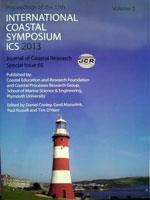Cooper, J.A.G., Green, A.N. and Smith, A.M. 2013. BARDEX II: Vertical stacking of multiple highstand shoreline deposits from the Cretaceous to the present: facies development and preservation.
A sequence of vertically stacked shoreline facies exposed by unprecedented water level lowering in Lake St Lucia, South Africa, records multiple occupation of the same shoreline (5–6m amsl) on at least eight occasions since the late Cretaceous. The sequence involves a basal wave-cut surface that is the outcrop of a regional unconformity cut into Late Cretaceous siltstone with occasional borings, representing a hardground (Facies 1). This is succeeded by a limestone unit indicative of sedimentation in a region of low terrigenous input quite different to today. This commences with a 10cm-thick unit comprising corals and giant clams that colonised the hardground as a shallow reef (Facies 2). The reef has an erosional upper surface that is overlain by a 30–50cm thick coquina (Facies 3) with characteristic sand-lined branching burrows, representing a coarse clastic beach unit. This is equated with the Uloa Formation of Miocene/Pliocene age. This unit has in turn been colonised by a patchy development of a coral reef of a single species, representing a renewed phase of reef development (Facies 4). The reef and the underlying Facies 3 have been waveplaned and eroded to form an erosional rocky shoreline with small potholes on a shore platform. The potholes are encrusted with barnacles and oysters to form a distinctive unit (Facies 5). The oysters and barnacles are encrusted with red algae suggesting a slight subsequent rise in sea level which is also associated with the formation of an erosional notch and a higher level shore platform with several small erosional gullies (Facies 6). These gullies are in turn encrusted by thick accumulations of serpulid worm tubes (Facies 7) into which two subsequent notches have been cut by wave action.
The shorelines preserved represent a succession of sea level highstands within a few metres of the contemporary sea level since Late Cretaceous times. They survived intervening sea level lowerings and fluvial incision by virtue of their location on an interfluve between adjacent incised valleys. Early cementation would have also been key to their preservation. Each shoreline facies was in turn influenced by the antecedent conditions imparted by the preceding shoreline as well as the contemporaneous conditions of sediment supply, sea level change and the surrounding palaeogeography. The presence of limestone and the absence of clasts or storm beach deposits suggests a protected coastline. The intermittent occurrence of coral and the reduced coral assemblage suggests that the water may not always have been fully marine.





